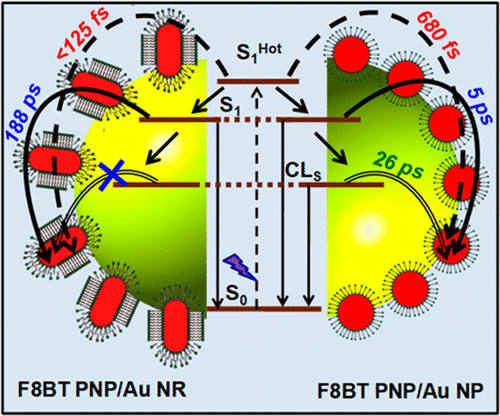当前位置:
X-MOL 学术
›
J. Phys. Chem. C
›
论文详情
Our official English website, www.x-mol.net, welcomes your
feedback! (Note: you will need to create a separate account there.)
Revealing Complex Relaxation Processes of Collapsed Conjugated Polymer Nanoparticles in the Presence of Different Shapes of Gold Nanoparticles Using Global and Target Analysis
The Journal of Physical Chemistry C ( IF 3.3 ) Pub Date : 2020-11-19 , DOI: 10.1021/acs.jpcc.0c08878 Arnab Ghosh 1 , Srijon Ghosh 1 , Goutam Ghosh 1 , Bikash Jana 1 , Amitava Patra 1, 2
The Journal of Physical Chemistry C ( IF 3.3 ) Pub Date : 2020-11-19 , DOI: 10.1021/acs.jpcc.0c08878 Arnab Ghosh 1 , Srijon Ghosh 1 , Goutam Ghosh 1 , Bikash Jana 1 , Amitava Patra 1, 2
Affiliation

|
Heterostructures of polymer and metal nanoparticles are extensively used in optoelectronic and light-harvesting depending on their charge transfer kinetics. Here, we investigate the influence of the shape of metal nanoparticles on the carrier relaxation processes of polymer nanoparticles (PNP) in poly(9,9-dioctylfluorene-alt-benzothiadiazole) (F8BT)-Au nanoparticle heterostructures using ultrafast transient absorption spectroscopy. Global and target analysis of transient absorption data is used to reveal the relaxation processes of hot singlet state, singlet state, and delocalized collective state of polymer nanoparticles in the presence of Au nanoparticles (NP), and Au nanorods (NR). In the case of Au NP, the energy transfer takes place from the hot singlet excited state (∼680 fs), and ultrafast electron transfer takes place from both the singlet excited state (∼5 ps) and collective delocalized state (∼26.2 ps) of F8BT polymer nanoparticles to Au NP. However, the very fast energy transfer from the singlet excited state (<125 fs) and ultrafast electron transfer (∼188 fs) from the singlet excited state of F8BT PNP are found in the presence of Au NR. Again, the diffusion length (LD) of F8BT PNP has changed from ∼1.97 to ∼1.65 nm in the presence of Au NP and ∼1.55 nm in the presence of Au NR. Thus, the shape of the metal nanoparticles plays an important role to control the charge transfer dynamics, which is decisive for designing efficient organic–inorganic heterostructure light-harvesting systems.
中文翻译:

使用全局和目标分析揭示在不同形状的金纳米粒子存在下塌陷的共轭聚合物纳米粒子的复杂弛豫过程
聚合物和金属纳米粒子的异质结构根据其电荷转移动力学而广泛用于光电和光收集领域。在这里,我们考察金属纳米粒子的形状对在聚聚合物纳米颗粒(PNP)的载体松弛过程的影响(9,9- dioctylfluorene-中高音-苯并噻二唑)(F8BT)-Au纳米颗粒异质结构,使用超快瞬态吸收光谱法。瞬态吸收数据的全局和目标分析用于揭示在存在Au纳米颗粒(NP)和Au纳米棒(NR)的情况下聚合物纳米颗粒的热单重态,单峰态和离域集体态的弛豫过程。在Au NP的情况下,能量转移是从热单重激发态(〜680 fs)发生的,超快电子转移是从单重激发态(〜5 ps)和集体离域态(〜26.2 ps)发生的F8BT聚合物纳米粒子对金纳米粒子的影响。但是,在Au NR存在的情况下,发现从F8BT PNP的单重激发态非常快的能量转移(<125 fs)和从F8BT PNP的极快电子转移(〜188 fs)。再次,在Au NP存在下,F8BT PNP的L D)从〜1.97改变为〜1.65 nm,在Au NR存在下从〜1.55 nm改变。因此,金属纳米粒子的形状在控制电荷转移动力学中起着重要作用,这对于设计有效的有机-无机异质结构光收集系统至关重要。
更新日期:2020-12-03
中文翻译:

使用全局和目标分析揭示在不同形状的金纳米粒子存在下塌陷的共轭聚合物纳米粒子的复杂弛豫过程
聚合物和金属纳米粒子的异质结构根据其电荷转移动力学而广泛用于光电和光收集领域。在这里,我们考察金属纳米粒子的形状对在聚聚合物纳米颗粒(PNP)的载体松弛过程的影响(9,9- dioctylfluorene-中高音-苯并噻二唑)(F8BT)-Au纳米颗粒异质结构,使用超快瞬态吸收光谱法。瞬态吸收数据的全局和目标分析用于揭示在存在Au纳米颗粒(NP)和Au纳米棒(NR)的情况下聚合物纳米颗粒的热单重态,单峰态和离域集体态的弛豫过程。在Au NP的情况下,能量转移是从热单重激发态(〜680 fs)发生的,超快电子转移是从单重激发态(〜5 ps)和集体离域态(〜26.2 ps)发生的F8BT聚合物纳米粒子对金纳米粒子的影响。但是,在Au NR存在的情况下,发现从F8BT PNP的单重激发态非常快的能量转移(<125 fs)和从F8BT PNP的极快电子转移(〜188 fs)。再次,在Au NP存在下,F8BT PNP的L D)从〜1.97改变为〜1.65 nm,在Au NR存在下从〜1.55 nm改变。因此,金属纳米粒子的形状在控制电荷转移动力学中起着重要作用,这对于设计有效的有机-无机异质结构光收集系统至关重要。











































 京公网安备 11010802027423号
京公网安备 11010802027423号